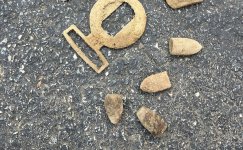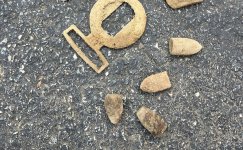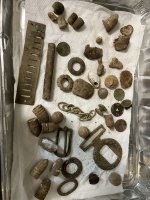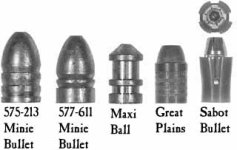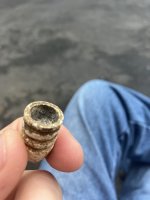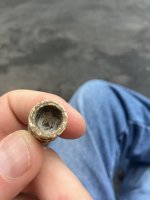Can anyone help id this bullet? Found in western chesterfield county va. Several other 3 ring Minnie balls and round balls found at same site. Dia. .571”, length 1.01”




Navigation
Install the app
How to install the app on iOS
Follow along with the video below to see how to install our site as a web app on your home screen.
Note: This feature may not be available in some browsers.
More options
You are using an out of date browser. It may not display this or other websites correctly.
You should upgrade or use an alternative browser.
You should upgrade or use an alternative browser.
🔎 UNIDENTIFIED Bullet ID
- Thread starter ncsuwolf
- Start date
- Thread starter
- #2
Correction
Can anyone help id this bullet? Found in western chesterfield county va. Several other 2 and 3 ring Minnie balls and round balls found at same site. Dia. .575”, length 1.01”View attachment 2159946View attachment 2159948View attachment 2159949View attachment 2159945
Upvote
0
- Thread starter
- #5
That’s what several have told me, but the fact it came from the middle of 25+ other period bullets makes me think otherwise. However, you your point I did dig a 5 gallon bucket of shotgun shell brass in the midst of it all. The flat point is what has everyone confused. I think nose cast bullet that got cut extra deep?I may be wrong, and probably am, but I think it is a more modern muzzle loading bullet. I am basing that on the unusually flat top.
Upvote
0
fyrffytr1
Gold Member
- Mar 5, 2010
- 7,562
- 12,045
- Detector(s) used
- XP Deus, White's DFX
- Primary Interest:
- All Treasure Hunting
Most, if not all of the period nose cast bullets I looked up were more rounded from the grooves to the flat tip. I hope someone more knowledgeable can properly ID it for you.
Upvote
1
RelicFinder77
Jr. Member
- Oct 21, 2022
- 92
- 184
.58 caliber 3 ringer. Civil war union round. Pretty odd to see the flat tip, but many times soldiers modified them during times of boredom.
Upvote
0
TheCannonballGuy
Gold Member
- Feb 24, 2006
- 6,584
- 13,310
- Detector(s) used
- White's 6000, Nautilus DMC-1, Minelab
- Primary Interest:
- Relic Hunting
Ncsuwolf, at this point, your mystery bullet's visible characteristics (notably, the extra-wide spacing of the body-grooves) AND the measurements you gave us match up with a "Lyman Mold" reproduction Minie-bullet for modernday blackpowder-rifle shooters.
Its .575-inch diameter is especially troublesome for what is supposed to be an actual Original civil war .58-caliber Minie-bullet. If you check various civil war bullet reference books, you'll see that the typical .58 Minie's diameter MINUS several hundredths-of-an-inch of lead-oxide patina is .570 or less. (Most civil war bullets that are pictured in the bullet-books are dug/excavated specimens, and still have the usual thick lead-oxide patina on them, so you MUST subtract the patina's thickness to know the bullet's original "as manufactured" diameter.)
The solution to the mystery will be found when you post several well-focused closeup photos of your mystery bullet's base cavity. The Lyman Mold repro 3-ring/groove Mine has a very deep, very wide "Paraboloid" cavity. That means that when you view the bullet's rim from the bottom, it looks a lot thinner than what is seen on a typical yankee "3-ringer."
I said the phrase "Paraboloid" cavity. Look up the meaning of "parabola" shape.
Put simply, in a typical cone-cavity Minie, the walls of the cavity are straight. (Shaped like a pencil-point after you sharpen it.) In a Parabola cavity, the walls are curved outward. For example, the nose of most Minie-bullets is a parabola shape.
If your mystery-bullet, which has extra-wide spacing between the grooves/rings, has an extra-large cavity which is Paraboloid shaped, it is a Lyman Mold repro. If your bullet has any of the "typical" Minie-bullet cavities, it is an 1864-65 era CS-made original civil war bullet, whose nose is unusually short and flat-tipped (and sunken-in a bit at the tip) because the person who cast the bullet did not quite fill the mold completely with the molten lead. (Note, that is also true if it is a Lyman Mold repro.... it is what we modern bullet-casters call a "short-pour" error bullet.
The photo attached below shows several versions of Lyman Mold repro bullets. Note, because TreasureNet's software trims off the edges of these "thumbnail" posted pics, you MUST CLICK ON IT to see the full image. if you don't click it, you can't see what I'm talking about. At far left is the Lyman Mold version of the 3-groove/3-ring Minie-bullet. Its .575" diameter is the same as your bullet. Note the extra-wide spacing of the rings/grooves, and also, the very short bottom ring. The 2nd bullet is the Lyman version of a Confederate Gardner 2-groove Minie-bullet.
Hoping this info is helpful,
TheCannonballGuy
Its .575-inch diameter is especially troublesome for what is supposed to be an actual Original civil war .58-caliber Minie-bullet. If you check various civil war bullet reference books, you'll see that the typical .58 Minie's diameter MINUS several hundredths-of-an-inch of lead-oxide patina is .570 or less. (Most civil war bullets that are pictured in the bullet-books are dug/excavated specimens, and still have the usual thick lead-oxide patina on them, so you MUST subtract the patina's thickness to know the bullet's original "as manufactured" diameter.)
The solution to the mystery will be found when you post several well-focused closeup photos of your mystery bullet's base cavity. The Lyman Mold repro 3-ring/groove Mine has a very deep, very wide "Paraboloid" cavity. That means that when you view the bullet's rim from the bottom, it looks a lot thinner than what is seen on a typical yankee "3-ringer."
I said the phrase "Paraboloid" cavity. Look up the meaning of "parabola" shape.
Put simply, in a typical cone-cavity Minie, the walls of the cavity are straight. (Shaped like a pencil-point after you sharpen it.) In a Parabola cavity, the walls are curved outward. For example, the nose of most Minie-bullets is a parabola shape.
If your mystery-bullet, which has extra-wide spacing between the grooves/rings, has an extra-large cavity which is Paraboloid shaped, it is a Lyman Mold repro. If your bullet has any of the "typical" Minie-bullet cavities, it is an 1864-65 era CS-made original civil war bullet, whose nose is unusually short and flat-tipped (and sunken-in a bit at the tip) because the person who cast the bullet did not quite fill the mold completely with the molten lead. (Note, that is also true if it is a Lyman Mold repro.... it is what we modern bullet-casters call a "short-pour" error bullet.
The photo attached below shows several versions of Lyman Mold repro bullets. Note, because TreasureNet's software trims off the edges of these "thumbnail" posted pics, you MUST CLICK ON IT to see the full image. if you don't click it, you can't see what I'm talking about. At far left is the Lyman Mold version of the 3-groove/3-ring Minie-bullet. Its .575" diameter is the same as your bullet. Note the extra-wide spacing of the rings/grooves, and also, the very short bottom ring. The 2nd bullet is the Lyman version of a Confederate Gardner 2-groove Minie-bullet.
Hoping this info is helpful,
TheCannonballGuy
Attachments
Upvote
8
- Thread starter
- #14
Wow….first, thank you very much for your in-depth response. I re-measure the piece, and depending on how it’s turned I get .573-.579. There is an odd (my opinion) ring within the skirt. I’ll add pics in a minute. One thing to add, which I mention earlier, when dug there was black powder still in the base, which make me think (I’m a novice) that it was a dropped paper round, which means arsenal. Not sure if repro rounds came wrapped in paper. Additional note, I found an almost identical ball online ( repro). Dixie gun works ba1103. I have reached out to them to see if they used a historical pattern for their mold, or if to your point in the Lyman model. Regardless of how it turns out, much appreciated.Ncsuwolf, at this point, your mystery bullet's visible characteristics (notably, the extra-wide spacing of the body-grooves) AND the measurements you gave us match up with a "Lyman Mold" reproduction Minie-bullet for modernday blackpowder-rifle shooters.
Its .575-inch diameter is especially troublesome for what is supposed to be an actual Original civil war .58-caliber Minie-bullet. If you check various civil war bullet reference books, you'll see that the typical .58 Minie's diameter MINUS several hundredths-of-an-inch of lead-oxide patina is .570 or less. (Most civil war bullets that are pictured in the bullet-books are dug/excavated specimens, and still have the usual thick lead-oxide patina on them, so you MUST subtract the patina's thickness to know the bullet's original "as manufactured" diameter.)
The solution to the mystery will be found when you post several well-focused closeup photos of your mystery bullet's base cavity. The Lyman Mold repro 3-ring/groove Mine has a very deep, very wide "Paraboloid" cavity. That means that when you view the bullet's rim from the bottom, it looks a lot thinner than what is seen on a typical yankee "3-ringer."
I said the phrase "Paraboloid" cavity. Look up the meaning of "parabola" shape.
Put simply, in a typical cone-cavity Minie, the walls of the cavity are straight. (Shaped like a pencil-point after you sharpen it.) In a Parabola cavity, the walls are curved outward. For example, the nose of most Minie-bullets is a parabola shape.
If your mystery-bullet, which has extra-wide spacing between the grooves/rings, has an extra-large cavity which is Paraboloid shaped, it is a Lyman Mold repro. If your bullet has any of the "typical" Minie-bullet cavities, it is an 1864-65 era CS-made original civil war bullet, whose nose is unusually short and flat-tipped (and sunken-in a bit at the tip) because the person who cast the bullet did not quite fill the mold completely with the molten lead. (Note, that is also true if it is a Lyman Mold repro.... it is what we modern bullet-casters call a "short-pour" error bullet.
The photo attached below shows several versions of Lyman Mold repro bullets. Note, because TreasureNet's software trims off the edges of these "thumbnail" posted pics, you MUST CLICK ON IT to see the full image. if you don't click it, you can't see what I'm talking about. At far left is the Lyman Mold version of the 3-groove/3-ring Minie-bullet. Its .575" diameter is the same as your bullet. Note the extra-wide spacing of the rings/grooves, and also, the very short bottom ring. The 2nd bullet is the Lyman version of a Confederate Gardner 2-groove Minie-bullet.
Hoping this info is helpful,
TheCannonballGuy
Upvote
2
- Thread starter
- #15
Wow….first, thank you very much for your in-depth response. I re-measure the piece, and depending on how it’s turned I get .573-.579. There is an odd (my opinion) ring within the skirt. I’ll add pics in a minute. One thing to add, which I mention earlier, when dug there was black powder still in the base, which make me think (I’m a novice) that it was a dropped paper round, which means arsenal. Not sure if repro rounds came wrapped in paper. Additional note, I found an almost identical ball online ( repro). Dixie gun works ba1103. I have reached out to them to see if they used a historical pattern for their mold, or if to your point in the Lyman model. Regardless of how it turns out, much appreciated.
Here are the pics….. cavity is ~.421 deep. One picture shows total cavity, the other is powder I didn’t clean wellNcsuwolf, at this point, your mystery bullet's visible characteristics (notably, the extra-wide spacing of the body-grooves) AND the measurements you gave us match up with a "Lyman Mold" reproduction Minie-bullet for modernday blackpowder-rifle shooters.
Its .575-inch diameter is especially troublesome for what is supposed to be an actual Original civil war .58-caliber Minie-bullet. If you check various civil war bullet reference books, you'll see that the typical .58 Minie's diameter MINUS several hundredths-of-an-inch of lead-oxide patina is .570 or less. (Most civil war bullets that are pictured in the bullet-books are dug/excavated specimens, and still have the usual thick lead-oxide patina on them, so you MUST subtract the patina's thickness to know the bullet's original "as manufactured" diameter.)
The solution to the mystery will be found when you post several well-focused closeup photos of your mystery bullet's base cavity. The Lyman Mold repro 3-ring/groove Mine has a very deep, very wide "Paraboloid" cavity. That means that when you view the bullet's rim from the bottom, it looks a lot thinner than what is seen on a typical yankee "3-ringer."
I said the phrase "Paraboloid" cavity. Look up the meaning of "parabola" shape.
Put simply, in a typical cone-cavity Minie, the walls of the cavity are straight. (Shaped like a pencil-point after you sharpen it.) In a Parabola cavity, the walls are curved outward. For example, the nose of most Minie-bullets is a parabola shape.
If your mystery-bullet, which has extra-wide spacing between the grooves/rings, has an extra-large cavity which is Paraboloid shaped, it is a Lyman Mold repro. If your bullet has any of the "typical" Minie-bullet cavities, it is an 1864-65 era CS-made original civil war bullet, whose nose is unusually short and flat-tipped (and sunken-in a bit at the tip) because the person who cast the bullet did not quite fill the mold completely with the molten lead. (Note, that is also true if it is a Lyman Mold repro.... it is what we modern bullet-casters call a "short-pour" error bullet.
The photo attached below shows several versions of Lyman Mold repro bullets. Note, because TreasureNet's software trims off the edges of these "thumbnail" posted pics, you MUST CLICK ON IT to see the full image. if you don't click it, you can't see what I'm talking about. At far left is the Lyman Mold version of the 3-groove/3-ring Minie-bullet. Its .575" diameter is the same as your bullet. Note the extra-wide spacing of the rings/grooves, and also, the very short bottom ring. The 2nd bullet is the Lyman version of a Confederate Gardner 2-groove Minie-bullet.
Hoping this info is helpful,
TheCannonballGuy
Attachments
Upvote
2
TheCannonballGuy
Gold Member
- Feb 24, 2006
- 6,584
- 13,310
- Detector(s) used
- White's 6000, Nautilus DMC-1, Minelab
- Primary Interest:
- Relic Hunting
Ncsuwolf, thank you for the effort of making and posting the excellent well-focused closeup photos I requested. They enable me to say with certainty, your bullet is NOT a Lyman-Mold repro.
I am not familiar with the Dixie Gun Works repro minie you mentioned. But I'll still say, in my opinion your bullet is an original Confederate-made Minie-bullet. Since I can't find a match for it (even taking the "short-pour" miscast nose into account) in any of the civil war bullet ID books I own, it seems to be a late-war version, not produced in large numbers. The "short-pour" casting error indicates it was made in-the-field by soldiers, not at an arsenal.
There is one other bullet-book I have not checked for your bullet. Its title is Round Ball To Rimfire: Part Four" by Dean S. Thomas. It is huge (several hundred pages, with several dozen bullets per page. At this time, I am too ill to even go find the book, which is in storage somewhere in my house. (See this post: https://www.treasurenet.com/threads...-for-the-what-is-it-forums-id-helpers.698123/ )
Hopefully somebody else here owns a copy of "Round Ball To Rimfire: Part Four."
I am not familiar with the Dixie Gun Works repro minie you mentioned. But I'll still say, in my opinion your bullet is an original Confederate-made Minie-bullet. Since I can't find a match for it (even taking the "short-pour" miscast nose into account) in any of the civil war bullet ID books I own, it seems to be a late-war version, not produced in large numbers. The "short-pour" casting error indicates it was made in-the-field by soldiers, not at an arsenal.
There is one other bullet-book I have not checked for your bullet. Its title is Round Ball To Rimfire: Part Four" by Dean S. Thomas. It is huge (several hundred pages, with several dozen bullets per page. At this time, I am too ill to even go find the book, which is in storage somewhere in my house. (See this post: https://www.treasurenet.com/threads...-for-the-what-is-it-forums-id-helpers.698123/ )
Hopefully somebody else here owns a copy of "Round Ball To Rimfire: Part Four."
Last edited:
Upvote
6
- Thread starter
- #17
Many thanks. I have looked through every bullet book I have as well, along with showing to folks who know these things, and no luck……thus the reason for me being here.Ncsuwolf, thank you for the effort of making and posting the excellent well-focused closeup photos I requested. They enable me to say with certainty, your bullet is NOT a Lyman-Mold repro.
I am not familiar with the Dixie Gun Works repro minie you mentioned. But I'll still say, in my opinion your bullet is an original Confederate-made Minie-bullet. Since I can't find a match for it (even taking the "short-pour" miscast nose into account) in any of the civil war bullet ID books I own, it seems to be a late-war version, not produced in large numbers. The "short-pour" casting error indicates it was made in-the-field by soldiers, not at an arsenal.
There is one other bullet-book I have not checked for your bullet. Its title is Round Ball To Rimfire: Part Four" by Dean S. Thomas. It is huge (several hundred pages, with several dozen bullets per page. At this time, I am too ill to even go find the book, which is in storage somewhere in my house. (See this post: https://www.treasurenet.com/threads...-for-the-what-is-it-forums-id-helpers.698123/ )
Hopefully somebody else here owns a copy of "Round Ball To Rimfire: Part Four.
Upvote
0
- Thread starter
- #18
One final question…..and I apologize for asking so much, am I wrong in assuming the black powder in the base came from a paper cartridge? Found several drops the same way at same site. Did soldiers in the field make paper cartridges, or were they simply loose ball and powder?Ncsuwolf, thank you for the effort of making and posting the excellent well-focused closeup photos I requested. They enable me to say with certainty, your bullet is NOT a Lyman-Mold repro.
I am not familiar with the Dixie Gun Works repro minie you mentioned. But I'll still say, in my opinion your bullet is an original Confederate-made Minie-bullet. Since I can't find a match for it (even taking the "short-pour" miscast nose into account) in any of the civil war bullet ID books I own, it seems to be a late-war version, not produced in large numbers. The "short-pour" casting error indicates it was made in-the-field by soldiers, not at an arsenal.
There is one other bullet-book I have not checked for your bullet. Its title is Round Ball To Rimfire: Part Four" by Dean S. Thomas. It is huge (several hundred pages, with several dozen bullets per page. At this time, I am too ill to even go find the book, which is in storage somewhere in my house. (See this post: https://www.treasurenet.com/threads...-for-the-what-is-it-forums-id-helpers.698123/ )
Hopefully somebody else here owns a copy of "Round Ball To Rimfire: Part Four."
Upvote
1
Top Member Reactions
-
 3044
3044 -
 1986
1986 -
 1687
1687 -
 1333
1333 -
 1301
1301 -
 1177
1177 -
 931
931 -
 838
838 -
 757
757 -
 720
720 -
 672
672 -
 534
534 -
 480
480 -
 467
467 -
E
435
-
 423
423 -
 369
369 -
 364
364 -
 311
311 -
 282
282
Users who are viewing this thread
Total: 3 (members: 0, guests: 3)


